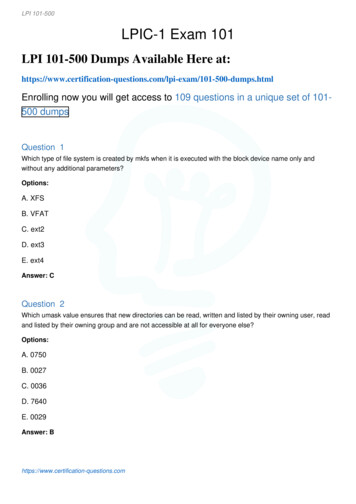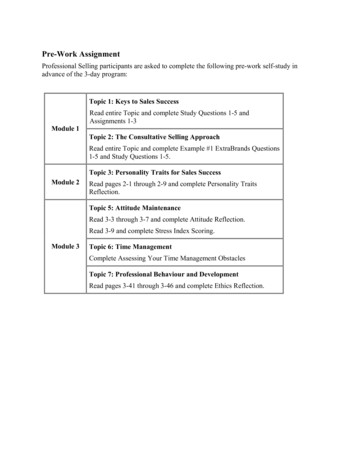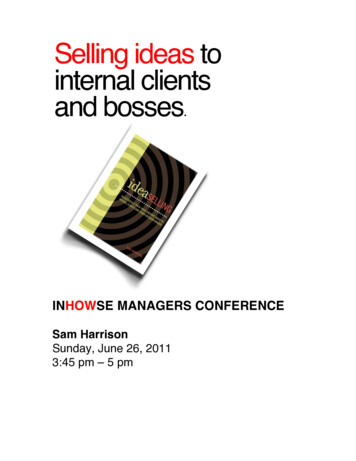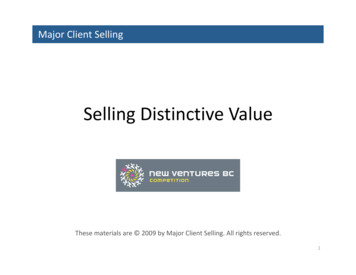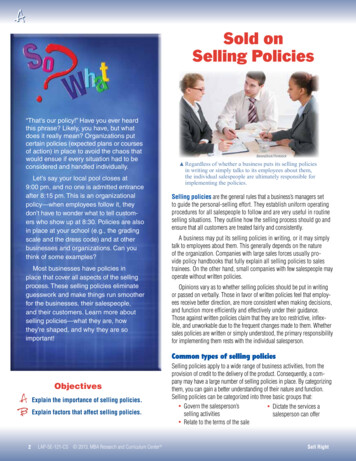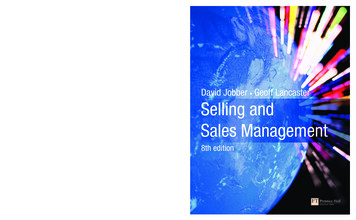
Transcription
2Personal Selling and Sales ManagementPersonal SellingandSales ManagementR. KRISHNAMOORTHYVisiting Professor,Management Institutes, Mumbai.Formerly National Sales Manager,Sandoz Agro Division.&General Manager (HR), Syngenta,Mumbai.MUMBAI NEW DELHI NAGPUR BENGALURU HYDERABAD CHENNAI PUNE LUCKNOW AHMEDABAD ERNAKULAM BHUBANESWAR INDORE KOLKATA GUWAHATI
3Nature and Scope of Sales Management AuthorNo part of this publication may be reproduced, stored in a retrieval system, or transmitted in any form orby any means, electronic, mechanical, photocopying, recording and/or otherwise without the priorwritten permission of the publishers.First Edition : 2015Published by: Mrs. Meena Pandey for Himalaya Publishing House Pvt. Ltd.,“Ramdoot”, Dr. Bhalerao Marg, Girgaon, Mumbai - 400 004.Phone: 022-23860170/23863863, Fax: 022-23877178E-mail: himpub@vsnl.com; Website: www.himpub.comBranch Offices:New Delhi: “Pooja Apartments”, 4-B, Murari Lal Street, Ansari Road, Darya Ganj,New Delhi - 110 002. Phone: 011-23270392, 23278631; Fax: 011-23256286Nagpur: Kundanlal Chandak Industrial Estate, Ghat Road, Nagpur - 440 018.Phone: 0712-2738731, 3296733; Telefax: 0712-2721216Bengaluru: No. 16/1 (Old 12/1), 1st Floor, Next to Hotel Highlands, Madhava Nagar,Race Course Road, Bengaluru - 560 001.Phone: 080-22286611, 22385461, 4113 8821, 22281541Hyderabad: No. 3-4-184, Lingampally, Besides Raghavendra Swamy Matham, Kachiguda,Hyderabad - 500 027. Phone: 040-27560041, 27550139Chennai: New-20, Old-59, Thirumalai Pillai Road, T. Nagar, Chennai - 600 017.Mobile: 9380460419Pune: First Floor, "Laksha" Apartment, No. 527, Mehunpura, Shaniwarpeth(Near Prabhat Theatre), Pune - 411 030. Phone: 020-24496323/24496333;Mobile: 09370579333Lucknow: House No 731, Shekhupura Colony, Near B.D. Convent School, Aliganj,Lucknow - 226 022. Phone: 0522-4012353; Mobile: 09307501549Ahmedabad: 114, “SHAIL”, 1st Floor, Opp. Madhu Sudan House, C.G. Road, Navrang Pura,Ahmedabad - 380 009. Phone: 079-26560126; Mobile: 09377088847Ernakulam: 39/176 (New No: 60/251) 1st Floor, Karikkamuri Road, Ernakulam,Kochi – 682011. Phone: 0484-2378012, 2378016 Mobile: 09387122121Bhubaneswar: 5 Station Square, Bhubaneswar - 751 001 (Odisha).Phone: 0674-2532129, Mobile: 09338746007Indore: Kesardeep Avenue Extension, 73, Narayan Bagh, Flat No. 302, IIIrd Floor,Near Humpty Dumpty School, Indore - 452 007 (M.P.). Mobile: 09303399304Kolkata: 108/4, Beliaghata Main Road, Near ID Hospital, Opp. SBI Bank,Kolkata - 700 010, Phone: 033-32449649, Mobile: 7439040301Guwahati: House No. 15, Behind Pragjyotish College, Near Sharma Printing Press,P.O. Bharalumukh, Guwahati - 781009, (Assam).Mobile: 09883055590, 08486355289, 7439040301DTP by: Priyanka M.Printed at: Geetanjali Press Pvt. Ltd., Nagpur. On behalf of HPH.
4Personal Selling and Sales ManagementDedicated tothe memory of our belovedGrandfather Late Shri V.E. Krishna Sastry, arenowned teacher, who inspired me and thestudents of Nallepilly Village, Palghat District,Kerala State for over three decadesandto our beloved father Late Shri S. Rama Iyer,Velonie Estate, Valparai, Coimbatore District,Tamil Nadu who demonstrated that “Work isWorship” in professional lifeandto my younger brotherLate R. Viswanathan who was a popular professorof Management Studies at Coimbatore.
Nature and Scope of Sales Management5PREFACE TO THE FIRST EDITIONIt gives me great please to present the First Edition of the book on “Personal Selling andSales Management” for the benefit of students, teachers and young executives engaged insales and marketing of products and services. The book covers the full syllabi on SalesManagement of most Indian Universities.I have included separate chapters on Field Salesman to Field Sales Manager, Selling toRural Consumers, Services Selling, Industrial Selling, Careers in Professional Selling, RecentTrends in Sales and Marketing and Ethics in Sales and Marketing based on discussions withsome of the sales and marketing professional across industries. I am thankful to all of themfor their valuable support.I have gained practical knowledge in Sales Management and Human ResourceManagement during my long professional career and have been teaching these subjects inManagement Institutes. I have made a humble effort to combine my teaching and corporateexperience in developing various chapters of the book.The book would serve as a comprehensive text book on ‘Sales Management’ a popularsubject introduced in all management institutes. Figures, tables, boxes and short case studieshave been included to enable the students to learn the concepts. The select bibliography onthe subject matter is given for further study and reference.I request the students, teachers, executives and others to provide constructivesuggestions to further improve the contents and quality of the book.I am thankful to Shri K.N. Pandey of Himalaya Publishing House Pvt. Ltd., for hisencouragement and kind co-operation in bringing out the first edition of the book.Mumbai 20.8.2015R. Krishnamoorthyvelonie@yahoo.com
6Personal Selling and Sales ManagementCONTENTS1. Nature and Scope of Sales Management1 – 20Introduction – Meaning of Market – Concepts of Market – Types ofMarket – Classification of Goods – Consumer Goods – Durable and Nondurable Products – High Involvement and Low Involvement Products –Core Marketing Concepts – Meaning of Marketing – Evolution ofMarketing Concepts – Caring for Customer – Consequences of MarketingConcept – Functions of Marketing – Selling versus Marketing – Meaningof Sales Management – Role of Sales Management in Marketing –Objectives of Sales Management – Functions of Sales Management –Conclusion – Study Questions – Case Study.2. Sales Environment21 – 34Environmental Factors Impacting Sales – Macro-environment – Microenvironment – Internal Environment – Changing Consumers Market –Challenges before the Sales Manager – Conclusion – Study Questions –Case Study.3. Sales Organisation35 – 49Importance of Sales Organisation – Developing an Effective SalesOrganisation – Coordination between Sales and Other FunctionalDepartments – Types of Sales Organisation – Basic Functions of SalesOrganisation – Conclusion – Study Questions – Assignment – CaseStudies.4. Role of Personal Selling in the Marketing-mix50 – 92Marketing-mix – Personal Selling and Marketing-mix – ConsumerDimension of Product Concept – Product Life-cycle – Product Life-cycleand Sales and Marketing Strategy – Brand – An Important Element ofMarketing-mix – Price – Pricing Strategies – Discounts – ManagingReceivables – Distribution Channel Decision – Channel Management –Channel Conflict – Direct Marketing – Promotion – Advertising – SalesPromotion – Major Decision Areas on Sales Promotion – Conclusion –Study Questions – Case Studies.5. Sales Planning93 – 112Business Planning – Sales Planning – Marketing-mix and Sales Strategy –Competitive Marketing Strategies – Sales Management in Action –Conclusion – Study Questions – Case Study.6. Sales Force PlanningSales Force Planning – Factors Affecting Sales Force Planning – Steps inSales Force Planning – Demand and Supply Forecasting of Sales Force113 – 138
Nature and Scope of Sales Management7Requirements – Separation Process – Forms of Separation – Promotion –Job Analysis – Job Enlargement – Review Questions – Assignment –Conclusion – Case Study.7. Sales Force Integration during Mergers and Acquisitions139 – 145Mergers and Acquisitions – Major Issues during Merger/AcquisitionTransition Phase – Transition Phase of the Sales Force Integration –Guidelines for Effective Integration of Sales Force in the NewOrganisation – Conclusion – Study Questions.8. Recruitment and Selection of Sales Force146 – 169Recruitment – Selection – Selection Tests – Selection Interview –Placement – Induction – Stages in Induction – Conclusion – StudyQuestions – Case Studies.9. Training and Development of Sales Force170 – 188Training – Development – Steps in Training – Evaluation of TrainingProgramme – Training Methods – On the Job Training Methods – Off theJob Training – Management Development – Methods of DevelopingManagers – Conclusion – Study Questions – Case Study.10. Sales Force Compensation189 – 202Compensation – Incentives – Bonus – Compensation Plan for Sales People –Reimbursement of Travel Expenses – Conclusion – Study Questions.11. Sales Force Motivation203 – 213Motivation – Morale – Job Satisfaction – Sales Force Counselling – SalesForce Retention – Conclusion – Study Questions – Case Study.12. Controlling the Sales Force214 – 220Planning and Control – Controlling the Sales Force – PerformanceEvaluation Criteria – How Control is Exercised? – Evaluation of SalesPerformance – Conclusion – Study Questions – Assignment.13. Performance Appraisal of Sales Force221 – 253Performance Appraisal – Objectives of Performance Appraisal – Types ofAppraisals – Performance Appraisal Process – Appraisal Interviews – PostAppraisal Activities – Requirements of a Good Performance AppraisalSystem – Performance Appraisal Methods – Traditional Methods –Modern Methods – Potential Appraisal – Problems Associated withPerformance Appraisal – Suggestions for Increasing the Effectiveness ofPerformance Appraisal System – Role of HR Manager in PerformanceAppraisal Process – Making Performance Appraisal a PositiveExperience – Conclusion – Study Questions – Case Study.14. Market Demand and Sales ForecastingDemand Concept – Forecasting – Sales Forecasting – Sales Forecast andMarketing Management – Methods of Sales Forecasting – Conclusion –254 – 268
8Personal Selling and Sales ManagementStudy Questions – Case Study.15. Sales Territory Management269 – 277Sales Territory – Routing, Scheduling and Time – Management – SalesMeetings – Conclusion – Study Questions.16. Sales Budget and Sales Target278 – 287Sales Budget – Contents of Sales Budget – Budgeting Approach – SalesTarget – Types of Sales Targets – Methods of Setting Sales Targets –Conclusion – Study Questions – Case Study.17. Personal Selling288 – 307Nature of Personal Selling – Sales Function and Marketing-mix –Salesmanship – Modern Concept of Salesmanship – Essentials of EffectiveSelling – Qualities of a Good Salesman – Theories of Selling –Conclusion – Study Questions.18. The Personal Selling Process308 – 328Steps in Personal Selling – Sales Presentation – Overcoming Objections –Product Objections – Price Objections – Objections between ChannelMembers and Company – Objections Regarding Promotion – SalesClose – Post-sales Contacts – Conclusion – Study Questions.19. Field Salesman to Field Sales Manager329 – 343Field Salesman – The Job of a Field Salesman – Visit to Distributors/Stockists/Dealers – Field Sales Manager – Conclusion – StudyQuestions – Assignment.20. Services Selling344 – 357Nature and Scope of Services – Challenges in Selling Services –Classification of Services – Problems of a Service Organisation – ServicesMarketing-mix – Channels of Distribution – Delivering Quality Service –Selling Services – Conclusion – Study Questions.21. Industrial Selling358 – 377Nature and Scope of Industrial Market – Channels of Distribution ofIndustrial Goods – Buying Centre – Personal Selling – The CustomerBank – Conclusion – Study Questions – Case Studies.22. Selling to Rural ConsumersRural Market – Rural Marketing – Growing Rural Market – Profile of RuralConsumer – Selling to Rural Consumers and The Role of 4Ps – PersonalSelling – Field Activities – Special Requirements of a Rural Salesman –Distributors’ Sales Staff – Conclusion – Study Questions – Case Study.378 – 40223. Careers in Professional SellingCareer – Selling – Why Selling as a Career? – Career Goals and CareerPath – Classification of Salesperson – Stages in Career Development –403 – 419
Nature and Scope of Sales Management9Succession Planning – Conclusion – Study Questions – Assignment –Case Study.24. Recent Trends in Sales and Marketing420 – 432Customer Relationship Management – e-Marketing – InternetMarketing – Marketing through Social Channels – Societal Marketing –Cause Related Marketing – Conclusion – Study Questions.25. Ethics in Sales and Marketing433 – 444Ethics – Marketing Ethics – Unfair Sales and Marketing Practices – Ethicsin Personal Selling – The Legal Aspects of Selling – AdvertisementStandards Council of India – Council for Fair Business Practices –Conclusion – Study Questions.Bibliography445
10Personal Selling and Sales Management1CHAPTERNATURE AND SCOPE OF SALESMANAGEMENTINTRODUCTIONIn good old days, goods were produced based on actual demand and hardly any selling effortwas required. The job of the salesperson was easy as he has to simply book orders. Remember thedays when a person had to make advance payment for a car or scooter and wait in the queue fordelivery! Waiting list of over two years was common for landline telephone connection. Thecustomers had to stand in the long queues to deposit and withdraw cash and the bank employeesworked on their whims and fancies. For more than a generation, life insurance was synonymouswith the state owned Life Insurance Corporation of India and customer service was lacking. Airtravel was restricted to the privileged group of the population and the Civil Aviation market wasmonopolised by Indian Airlines. The public had limited choice of consumer goods, durables andservices. There was a craze for foreign goods such as wrist watches, transistors, television sets,cameras and non-resident Indians returning from foreign countries used to bring consumer durableswhich were in high demand in domestic market. Today the market situation has completedchanged and high quality branded goods are available in domestic market.Our economy, based on socialist pattern of growth and development, has moved awayfrom Licence Raj and centrally controlled system to free economy. These reforms, introduced in1991, in the form of liberalisation, deregulation, relaxation of trade and investment controls andprivatisation have led to increase in exports and foreign exchange reserves, higher competitionand efficiency in the market place and availability of variety of goods and services. The resulthas been a sharp rise in income and consumption, especially among the middle class in urbanand rural areas. The economic policies have resulted in major changes in the marketingenvironment of the country. Our country with a population of over 120 crores is one of thebiggest markets in the world for a number of goods and services such consumer goods, durables,financial services, education, health care, telecommunication and the list continues.The return of the multinationals such as Co-Cola and IBM to India and entry of many otherMNCs such as General Electric, Pepsi, Motorola, Proctor and Gamble, Nokia, LG, Ford,Hyundai, Sony, Samsung clears proves that India has a vast market rising income a boomingmiddle class, rising rural elites with adequate purchasing power, offering long-term
Nature and Scope of Sales Management11opportunities for Indian and foreign industries.There is a definite shift from sellers’ market to buyers’ market and consumer shall be centreof the entire business system. All business operations revolve around consumer satisfaction andservice. Guaranteed route to profit is through customer satisfaction.Today, the market is flooded with different brands of consumer goods. The consumer has awide choice and he is demanding more and more for less and less. The competition isincreasing in the market place and companies are wooing the consumers with discounts andschemes. Senior managers are tremendous pressure to show results. Some of the commonstatements we hear in corporate meetings are “We have to be pro-active, otherwise we will beleft out, Perform or Perish, Change or we will be left out, the situation is bad and calls fordramatic transformation”.Under this dynamic business environment, sales management, an integral part of marketingmanagement, plays a major role in meeting the business objectives of the organisation. Salesmanagement is concerned with generating revenue for the organisation and management ofsales force. Sales force is the backbone of an organization since the ultimate aim of productionis sales. The salesperson's job has expanded far beyond merely booking orders. In fact, thesalesperson is the carrier of creative and innovative messages to the consumers in the society.Therefore the success of an enterprise depends to a large extent, on an efficient salesorganization.MARKET AND MARKETINGFor a meaningful discussion on sales management, it is necessary to touch upon a fewconcepts about market and marketing.Meaning of MarketThe word ‘market’ is derived from the Latin word “Marcatus” meaning goods or trade or aplace where business is conducted. Traditionally market refers to a physical location wherebuyers and sellers gather to exchange their goods. In the market, ownership and possession ofproducts are transferred from the seller to the buyer and money acts as a medium of exchangeand measure of value. Economists describe a market as a collection of buyers and sellers whotransact over a particular product or service. Marketers view sellers as the industry and thebuyers as the market. Business people use the term market to refer to various grouping ofcustomers such as Product market (Example: Television market), Geographic market (Example:African market) or Non customer group such as Labour market. However the term has a widermeaning and it is not confined to a particular area or place where buyers and sellers meet toexchange goods. It is now generally used to mean any body of persons who are in intimatebusiness relations and carry on extensive transactions in any commodity. Let us see a fewdefinitions of market.1. According to Philip Kotler, “A market consists of all the potential customers showing aparticular need or want who might be willing and able to engage in exchange tosatisfy the need or want.”
12Personal Selling and Sales Management2. According to William J. Stanton, “A market may be defined as a place where buyers andsellers meet, goods and services are offered for sale and transfer of ownership occurs.”3. The American Marketing Association defines a market as “the aggregate demand of thepotential buyers for a product or service.” The term market as a group of persons is alsoused to represent the total customer demand. In this sense, market means people withneeds to satisfy, the money to spend and the will to spend money to satisfy their wants.It is quite clear from the above definitions, that “Market” does not necessarily mean aphysical place. It is an area in which forces of demand and supply operate directly or by meansof any kind of communication to bring about transfer of the title of the goods.Concepts of Market(1) Place Concept: A market is a convenient meeting place of buyers and sellers to gathertogether in order to conduct buying and selling activities. It is a physical locationwhere things are bought and sold and where buyers and sellers personally meet toaffect purchase and sales. Examples: Vegetable/Fruit market.(2) Area Concept: A market develops in any area, small or large, the moment there arethree pre-requisites for exchange: (a) Two or more individuals have unmet wants,(b) They have products to meet the demand, and (c) They have some means ofcommunication such as telephone, fax, correspondence, electronic mail or Internet.With the means of communication, forces of demand and supply can freely operate todetermine the prices and buyers and sellers can establish close and continuouscontacts to carry on the exchange of products without formal face-to-face meeting.Example: Money market is a highly organised market for the entire nation without anycentral meeting place for borrowers or lenders of money.(3) Demand Concept: Today, a market is equated with the total demand. Hence, marketmeans a group of people having unmet wants, purchasing power and the will to spendtheir income to satisfy those wants. Example: The domestic market for pharmaceuticalproducts was 40,000 crore (2010). The human being is a wanting animal, havingnever-ending, varied and ever changing wants. The process of want-satisfaction iscontinuous and sellers want to create, capture and retain the market (customer demand)for their goods.Market CommunicationBody ofSellersFlow ofProductsMarketThe Circleof ExchangeFeedbackInformation:Satisfaction &Body ofBuyersFlow ofMoney
13Nature and Scope of Sales ManagementDissatisfactionFig. 1.1 The Market (Exchange Process)Types of Market1. Selling Area Covered: According to the area covered, the market may be classified asLocal, Regional, National and International market.2. Commodities Traded: The market is differentiated based on the product sold, i.e.,Cotton market, Tea market, Bullion market, etc.3. Nature of Dealings: The market may be Spot/Cash market or Future/Forward market.While in spot market, goods are bought and sold immediately, in the case of future market,actual buying and selling take place at a future time as agreed by the buyer and seller.4. Nature of Goods Sold: The market may be for consumer goods or for industrial goods.Consumer goods are meant for direct consumption/use of consumers, whereas industrial goodsare generally needed by manufacturers in the process of production.5. On the Basis of Time Interval, markets may be classified into Short-term market andLong-term market. Example: Money market for short-term period and capital market for longterm funds.6. Volume of Business Transactions: The market may be a Wholesale market or Retailmarket according to the nature and volume of business.7. Competition: On the basis of competition, the market may be Competitive market orMonopolistic market.8. Functioning of the Market: The market may be an Unorganised market or an Organisedmarket. Example: Regulated markets run by State Governments are organised markets foragricultural produce.9. Dominance of the Parties: The market may be Sellers’ market or Buyers’ marketdepending upon the demand and supply of product and services.10. Sellers Position: The market may be Primary market where farmers sell the produce tothe traders or Secondary market where buying and selling take place between traders. In thecase of Terminal market, the produce is assembled for export or for consumption of the localpopulation.Classification of GoodsThere are three types of goods as shown below:1. Manufactured goods may be consumer goods needed for use or consumption byconsumers or industrial goods needed for use by producers in the process ofproduction.2. Agricultural goods may be in the form of raw materials for industry (cotton, sugarcane)or consumer goods for immediate consumption.3. Natural raw materials are the free gifts of nature and they are the raw materials of
14Personal Selling and Sales Managementindustry such as iron ore.ProductsNaturalRaw ndustrialGoodsFig. 1.2 Types of GoodsConsumer GoodsProf. M.T. Copeland developed three-fold classification of consumer goods based ontypical buying habits of consumers, i.e., how, when and where consumers usually buycommodities. The three categories of consumer goods are: (1) Convenience goods. (2) Shoppinggoods, and (3) Speciality goods. The salient features of these goods are given in Fig. 1.3.Durable and Non-durable ProductsAs the term suggests, durable products offer tangibility and durability. Non-durableproducts are normally consumed fast and purchased regularly.(1) Fast moving consumer goods usually refer to non-durable products. They are alsoknown as Consumer Packaged Goods. Normally consumers spend less time and effort in buyingthese goods. FMCG includes a variety of products such a soap, biscuit, shampoo, toothpaste,talcum powder etc. They are relatively high volume and low value products. They are a largenumber of stock keeping units to meet the needs of consumers. Packaging plays a major role inattracting the attention of consumers The capital investment in setting up a factory is low andmajor investment is in brand promotion and distribution. Launching a new product requiresheavy investment and the marketer has to continue to focus on 4Ps to fight competition andachieve desired volumes and profits.(2) Consumer durables are tangible goods and are used over an extended period of time.They are purchased once in a few years. Examples: TV, Refrigerator etc. The consumer spend lotof time in collecting information about various brands/models, discusses with neighbours andfriends, check the prices from various outlets before making purchase decisions. The consumersare concerned about perceived risk and aftersale service. Therefore, personal selling andaftersale service play an important role in selling consumer durables.
15Nature and Scope of Sales ManagementConvenience GoodsShopping GoodsSpeciality GoodsLow priced goods, Frequentpurchases with minimum effort,High replacement rate, Purchasesin small quantities, Must beavailable at nearest store. Selfservice stores are ideal for suchgoods.Are not purchased regularly,Planned purchases with considerable efforts, Purchases basedon quality, style, price, suitability,Purchases can be postponed, Donot need numerous outletsLess frequent purchases, Purchasesonce in a few years, High pricedgoods requiring high investments,Available in speciality shopsExamples: Women’s clothing,furniture, shoes, hardware, majorappliances.Examples: Bread, milk, toothpaste, snacks, soap, newspaper,tobacco products.Marketing MethodsMarketing MethodsExamples: TV, CD players, expensive watches, cars, refrigerators,ornaments, cameras.Marketing Methods1. Numerous outlets.1. Limited outlets.1. Limited outlets.2. Quick sales turnover.2. Medium turnover.2. Low turnover3. Sales through wholesaler andretailer.3. Direct sales to retailer.3. Direct sales to retailer.4. Packaging as a silent salesman.4. Packaging has a minor role.4. Packaging has no promotionvalue.Note: The distinction between convenience and shopping goods is clear and easily understandable. But the distinctionbetween shopping and speciality goods is not quite clear. Many products are classified in both categories.Fig. 1.3 Types of Goods ComparedHigh Involvement and Low Involvement ProductsInvolvement refers to how much time, thought and energy consumers devote to thepurchase process. High involvement products include car, major electronic appliances andresidential flat. Many of the FMCG would come under low involvement products and consumerspends less time and energy in buying these goods.MARKETINGCore Marketing ConceptsA marketer is someone seeking a response from another party known as prospect. If twoparties are seeking to sell something to each other, we call them both marketers.A Prospect is someone whom the marketer identifies as potentially willing and able toengage in exchange of values.Needs describe basic human requirements like water, air, food, clothing and shelter. Theyalso need education, entertainment and recreation. Needs are not created by marketing persons.Needs become wants when they are directed to specific objects that might satisfy the need.A person needs water but wants Frooti. Wants are shaped by society. Human needs are limited,
16Personal Selling and Sales Managementbut wants are unlimited.Demands are wants for specific products backed by ability to pay. Many people wantBlackBerry, but only a few are able and willing to buy one. Therefore, marketers do not createneeds and rather influence the wants.Exchange involves obtaining a desired product from someone by offering something inreturn. Five conditions exist in exchange process.(a) Existence of at least two parties.(b) Each party has something that might be of value to other party.(c) Each party is capable of communication.(d) Each party is free to accept or reject the offer.(e) Each party would like to deal with the other party.Exchange takes place when both the parties agree on terms and conditions. Normally,exchange is beneficial to both parties. Exchange is a process. Two parties are involved inexchange and they are trying to arrive at mutually agreeable terms. When an agreement isreached, we say that a transaction has taken place. ‘A’ sells an Air conditioner and ‘B’ pays 15,000/- and this is an example of a monetary transaction. However, a barter systems involvestrading of goods or services for other goods or services. In many villages, labourers are paid inkind in the form of rice, wheat, etc., instead of wages.In a transfer, ‘A’ gives to ‘B’, but ‘A’ does not receive anything tangible in return.Donations to political parties, gifts, etc. are transfers. Normally, the transferer receives thank youletters, house magazines and invitations to events.Value and SatisfactionAccording to Louis DeRose “Value is the satisfaction of customer requirements at thelowest possible cost of acquisition, ownership and use”.A product will be successful if it delivers value and satisfaction to the buyer. Value is aratio between what the customer gets and what he gives. The customers gets functional benefitsand emotional benefits. The cost include monetary costs, time costs, energy costs, etc. Therefore,value Benefits Costs.A marketer can increase the value of the product through raising benefits, reducing costs,raising benefits by more than the raise in costs and lower benefits by less than the reduction in costs.Satisfaction is a function of perceived performance and expectations. If the performance fallsshort of expectations, the customer is dissatisfied. If the performance matches his expectations,the customer is satisfied. If the performance exceeds expectations, the customer is delighted.Meaning of MarketingMarketing is a comprehensive term and it includes all resources and a set of activitiesnecessary to direct and facilitate the flow of goods and services
Nature and Scope of Sales Management 5 PREFACE TO THE FIRST EDITION It gives me great please to present the First Edition of the book on "Personal Selling and Sales Management" for the benefit of students, teachers and young executives engaged in sales and marketing of products and services. The book covers the full syllabi on Sales
